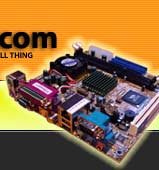The Apollo CLE266 Chipset
Underneath the aluminium double heatsink lies
the VT8235 South Bridge and CLE266 North Bridge (on the right).
Both of these support chips together are referred to as the
VIA Apollo CLE266 chipset. The EPIA M9000 and EPIA ME6000
have a much smaller heatsink just over the North Bridge.
CLE266 North Bridge
The North Bridge connects the CPU at high
speed to the major internal interfaces on the computer, i.e.
the memory, PCI bus and AGP port (if present). It also connects
to the South Bridge. The CLE266
North Bridge also provides on-board video with an integrated
"Unichrome" graphics core (aka CastleRock), from
VIA's graphics subsidiary, S3. UniChrome is primarily a 128-bit
2D graphics engine optimised for multimedia playback, although
it does have a 64-bit 3D graphics engine for rudimentary 3D
tasks. Most importantly, Unichrome has an integrated MPEG-2
decoder with video scaling for high quality hardware-based
DVD acceleration. The CLE266 supports CRT, LCD or TV dual
display technology, dual video inputs (although the EPIA M
has no video input) and supports DDR (Double Data Rate) SDRAM
memory modules.
VT8235 South Bridge
The South Bridge connects many "slower"
(in computing terms) external interfaces to the North Bridge
and then to the CPU. The VT8235
South Bridge includes integrated support for up to 6 USB 2.0
ports, ATA-133, 10/100Mbps Ethernet, PCI, 6 Channel AC-97
Surround Sound, and connectivity to the North Bridge by the
V-Link interface.
Supporting Chips
Many of the supporting chips on the EPIA Ms
were upgraded from the classic EPIAs to add or improve on
input and output functionality. Here are details of a few
of them.
VT1616 Six-TRAC Audio Codec
The VT1616
audio codec links to the South Bridge and handles analogue
to digital conversion of audio output streams, and digital
to analogue conversion of audio input. It's VIA's answer to
Realtek's ALC650 codec, included on many current motherboards.
As memorising chip model numbers isn't the most exciting thing
most people would like to do, VIA now call it the VIA Vinyl
Six-TRAC. The Six-TRAC can support 6 output channels for 5.1
surround audio, and 12 input channels configured as 5 stereo
pairs and 2 mono inputs. On the EPIA Ms, 4 input channels
are utilised - the Line and Microphone level input jacks.
VIA recently licenced surround sound software
technology from Sensaura,
who have also worked with NVidia's nForce boards and on the
Xbox. The new marketing name for this software and the Apollo
CLE266 chipset is "Vinyl Audio". The EPIA Ms conveniently
have this chipset. The latest
audio driver was recently released, and is the first to
include the DirectSound3D compatible Sensaura technology.
The driver is of course called "Stylus"...
VT1622M Digital TV Encoder
The EPIA Ms use the VT1622M
Digital TV Encoder, a step up from the VT1621 used in classic
EPIAs. The VT1622M supports composite,
S-Video, component interlaced and progressive
scan output, although the EPIA Ms do not have the necessary
RGB interface to output progressive scan video.
VT6103
Networking Controller - used on all the EPIAs. Provides support
for the onboard 10/100 ethernet.
VT1211
Super I/O Controller - provides a floppy disk controller,
parallel interface support, and adds hardware monitoring of
fan speed and cpu temperature (the classic EPIAs don't have
this available to the OS)
VT6307S
Fire IIM 1394 Host Controller - 2-port IEEE 1394 (Firewire)
host controller. Firewire ports can be connected to the 2
headers on the motherboard using the provided Firewire / USB
2.0 module. Many EPIA cases have their own modules built into
the front panel.
Back Panel
Connectors -->







